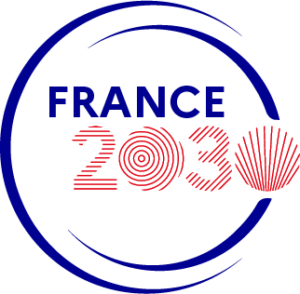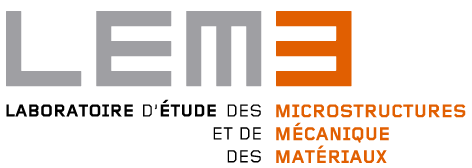Under the aegis of the Medicis programme



Abstract
Interfaces, whether grain boundaries in polycrystalline materials or heterointerfaces in multiphase solids, are ubiquitous in materials science and engineering. Far from being simple separation surfaces between neighboring crystals, understanding the role of solid-solid interfaces represents a major challenge, requiring advanced theoretical and numerical strategies to describe their physical and mechanical characteristics.
The first part of this presentation is dedicated to microstructures dominated by interfaces, resulting from polymorphic (diffusionless) phase transformations. Under high hydrostatic compression and shock wave conditions, pressure-induced phase transitions and the formation of diffuse internal interfaces in iron are modeled within a thermodynamically coherent framework, combining nonlinear elastoplasticity and a multivariate phase-field approach adapted to large deformations.
The second part focuses on the detailed description of imperfect interfaces, particularly semi-coherent interfaces, characterized by networks of geometrically necessary dislocations that induce a deformation preserving lattice invariance. This deformation disrupts the uniformity of crystallographic correspondence across the interface, thereby reducing coherence. A constitutive law, integrating the contribution of geometrically necessary dislocations and designed for high-performance calculations on complex structures (in particular turbine blades), will also be presented.
Résumé
Les interfaces, qu’il s’agisse des joints de grains dans les matériaux polycristallins ou des hétérointerfaces dans les solides multiphasés, sont omniprésentes en science et en ingénierie des matériaux. Loin d’être de simples surfaces de séparation entre cristaux voisins, comprendre le rôle des interfaces solide-solide représente un défi majeur, nécessitant la mise en œuvre de stratégies théoriques et numériques avancées pour décrire leurs caractéristiques physiques et mécaniques.
La première partie de cette présentation est consacrée aux microstructures dominées par les interfaces, résultant de transformations de phase polymorphiques (sans diffusion). Sous haute compression hydrostatique et en conditions d’ondes de choc, les transitions de phase induites par la pression, ainsi que la formation d’interfaces internes diffuses dans le fer, sont modélisées dans un cadre thermodynamiquement cohérent combinant l’élastoplasticité non linéaire et une approche phase-field multivariant adaptée aux grandes déformations.
La seconde partie s’intéresse à la description fine des interfaces imparfaites, en particulier des interfaces semi-cohérentes, caractérisées par des réseaux de dislocations géométriquement nécessaires induisant une déformation préservant l’invariance du réseau. Cette déformation perturbe l’uniformité de la correspondance cristallographique à travers l’interface, réduisant ainsi la cohérence. Une loi de comportement, intégrant la contribution des dislocations géométriquement nécessaires et destinée aux calculs haute-performance sur structures complexes (notamment les aubes de turbine), sera également présentée.
To attend on teams
It is also possible to attend the seminar on Microsoft Teams.





